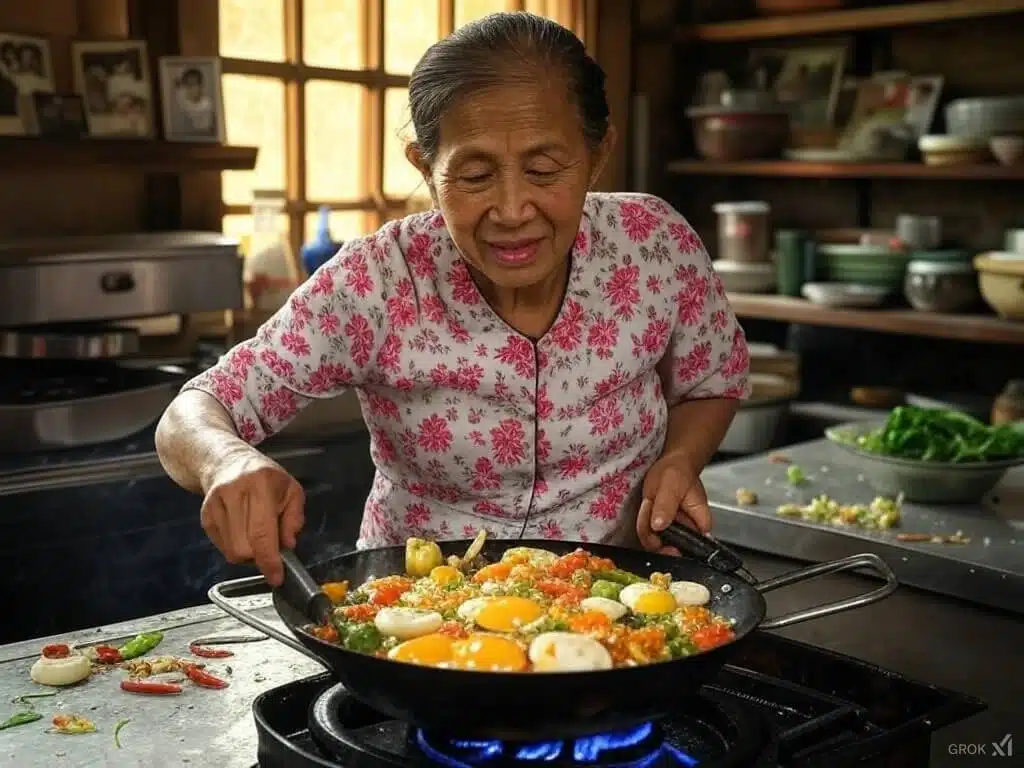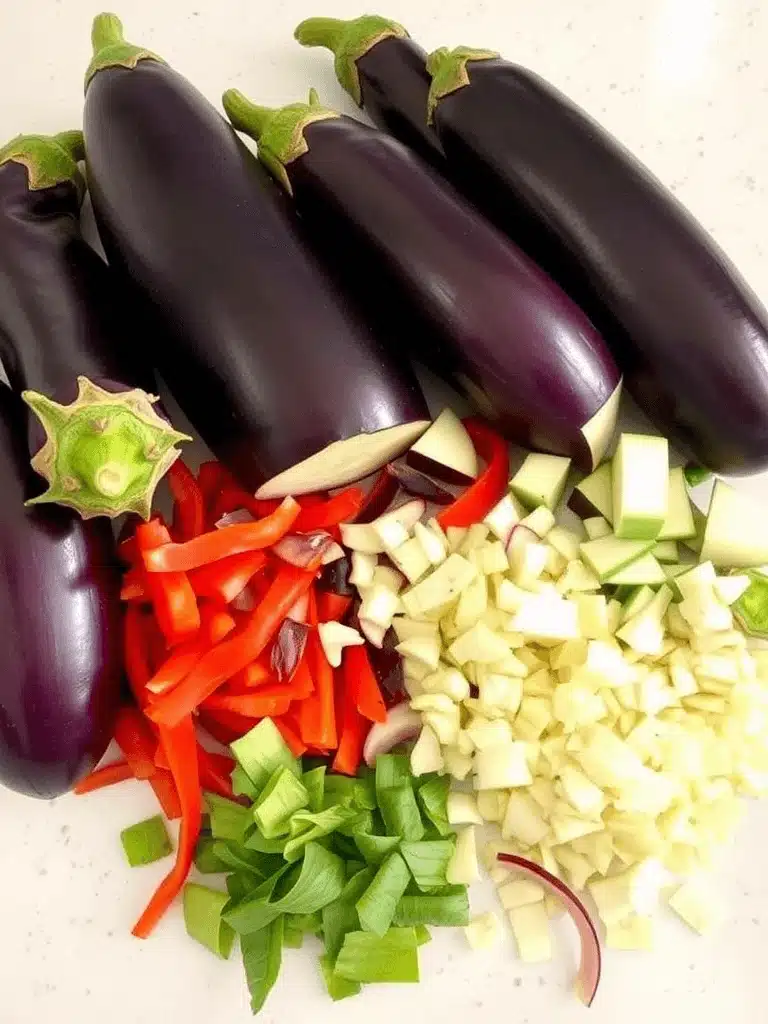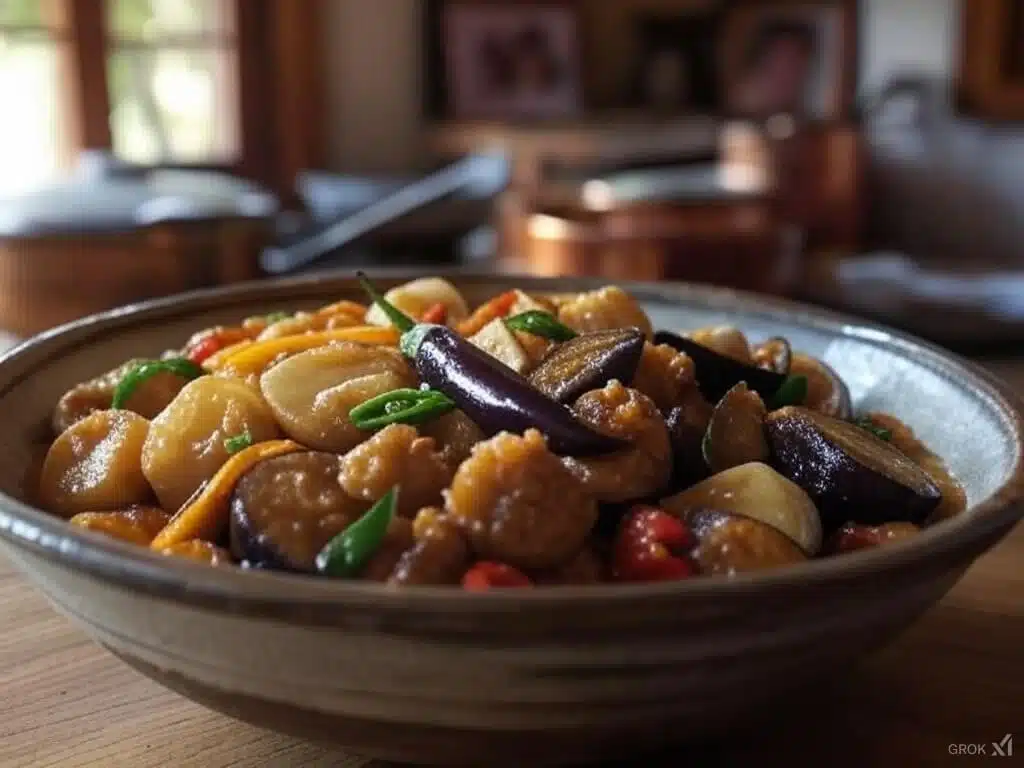If you’re a fan of bold flavors and vibrant dishes, let me tell you a little story that will make this Thai eggplant recipe even more special. You see, every time I prepare this dish, I am transported back to my childhood, sitting in Grandma’s cozy kitchen, watching her work her magic with simple ingredients 8. She would lovingly refer to these tiny but mighty Thai eggplants as “the heart of the meal,” explaining how they brought balance and freshness to our family feasts.
Grandma had a way of making everything feel like an adventure, especially when she cooked. She’d start by carefully selecting each eggplant, ensuring they were just right—firm and full of potential. With hands that moved with practiced ease, she’d chop them up while sharing tales from her youth, stories filled with laughter and lessons about life and love. The aroma of sizzling garlic and chilies mingling with the earthy scent of the eggplants was intoxicating, filling the house with warmth and anticipation 4.
This dish isn’t just food; it’s a piece of history, a connection to roots, and a reminder of the joy found in cooking together. So whether you’re a seasoned chef or a home cook looking to try something new, preparing this recipe is sure to impress—and perhaps evoke memories of your own. Let’s embark on this flavorful journey inspired by tradition, bringing the authentic taste of Thailand right into your kitchen, infused with the same love and care Grandma always gave us.


Table of Contents
Ingredients to Make Our Thai Eggplant Recipe
Here’s everything you’ll need to create this delicious dish:
| Ingredient | Quantity | Note |
|---|---|---|
| Thai eggplants | 4 | Cut into bite-sized pieces |
| Coconut milk | 1 can | Full-fat for a richer flavor |
| Red curry paste | 2 tbsp | Adjust to taste for spice level |
| Fish sauce | 2 tbsp | Substitute with soy sauce for vegetarian |
| Palm sugar | 1 tbsp | Can use brown sugar as an alternative |
| Fresh basil leaves | 1 cup | Thai basil preferred for authentic taste |
| Kaffir lime leaves | 3 | Optional, but adds a unique aroma |
| Red bell pepper | 1 | Sliced thinly |
| Garlic cloves | 3 | Minced |
| Vegetable oil | 2 tbsp | For sautéing |
| Lime juice | 1 tbsp | Freshly squeezed for a zesty finish |
| Green onions | 2 | Chopped for garnish |


Kitchen Equipment Needed
To ensure the success of your Thai eggplant recipe, you’ll need the following tools:
- Wok or large skillet: Essential for stir-frying the ingredients.
- Sharp knife: For chopping vegetables.
- Cutting board: A sturdy surface for preparing ingredients.
- Measuring spoons and cups: To ensure accurate ingredient quantities.
- Mortar and pestle: Optional, but great for crushing garlic and herbs to release their full flavor.
Instructions
Let’s dive into this recipe with love, passion, and a sprinkle of joy! Cooking isn’t just about following steps—it’s about infusing each ingredient with care and creating something truly special. Here’s how we can make this dish together, step by step, while embracing the beauty of cooking:
1. Prepare Your Ingredients: A Moment of Connection:
Start by giving your ingredients some love right from the beginning. Wash those vibrant Thai eggplants gently, as if they were little treasures, then cut them into bite-sized pieces that are just perfect for popping into your mouth. Slice the red bell pepper into thin strips, letting its sweetness shine through later in the dish. Mince the garlic cloves finely—this is where you channel your inner chef, making sure every piece is uniform so it cooks evenly. If you’re using kaffir lime leaves, tear them slightly to release their magical aroma; think of it as waking up their essence to dance with the other flavors 1. This preparation stage is like setting the foundation for a masterpiece.
2. Heat the Oil: Building the Base
Heat your wok or large skillet over medium heat and add the vegetable oil. Once the oil is shimmering, toss in the minced garlic and let it sizzle for about 30 seconds until fragrant. Breathe in deeply—you’re already filling your kitchen with warmth and anticipation. Remember, this step isn’t just about cooking garlic; it’s about building the base flavor that will carry the entire dish. Treat it with respect, because every second counts here!
3. Add the Curry Paste: The Heart of the Dish
Now comes one of the most important moments: adding the red curry paste. Stir it in carefully and cook for about 1 minute, allowing the spices to bloom and meld together. Don’t rush this part—think of it as giving the curry paste time to share its story with the rest of the ingredients. Skipping this step could leave your dish feeling incomplete, but trust me, I’ve learned the hard way that patience pays off 4.
4. Cook the Eggplant: Dancing Through the Pan
Add the Thai eggplants to the wok and stir-fry them for about 5 minutes. Keep them moving constantly to prevent sticking, almost like dancing with them around the pan. Watch as they soften and start to absorb the rich flavors surrounding them. It’s a beautiful transformation, and you’re the conductor of this culinary symphony.
5. Pour in the Coconut Milk: Embracing Creaminess
Next, pour in the coconut milk, fish sauce, and palm sugar. Stir everything together lovingly, ensuring all the ingredients are perfectly combined. Let the mixture come to a gentle simmer, releasing waves of creamy goodness. Take a moment to appreciate the harmony of flavors coming together—this is the heart of Thai cooking, where balance reigns supreme.
6. Simmer: Where Magic Happens
Let the mixture simmer for about 10 minutes. During this time, the eggplants will soak up the rich, creamy sauce, becoming tender and infused with flavor. This is where the real magic happens, so resist the urge to rush things. Instead, use this time to reflect on the journey of the dish, imagining the smiles it will bring once served.
7. Add the Vegetables: Brightening the Plate
Toss in the sliced red bell peppers and kaffir lime leaves. Cook for an additional 5 minutes, or until the bell peppers are tender but still crisp. These final touches bring brightness and freshness to the dish, reminding us that even at the end, there’s always room for a little extra sparkle.
8. Finish with Basil and Lime: The Grand Finale
Just before serving, stir in the fresh basil leaves and squeeze in some lime juice. These final additions elevate the dish, bringing a burst of fragrance and tang


Tips and Tricks
- Adjusting Spice Levels: If you prefer a milder dish, reduce the amount of red curry paste. For more heat, add a few slices of fresh chili. Remember, it’s easier to add spice than to take it away!
- Avoiding Soggy Eggplant: Make sure not to overcrowd the pan when cooking the eggplants. This ensures they cook evenly and maintain a nice texture. If necessary, cook them in batches.
- Chef’s Advice: Always taste and adjust the seasoning before serving. A little extra fish sauce or sugar can make a big difference. And don’t forget the lime juice—it brightens up the whole dish!
Thai Eggplant Serving Suggestions
Your Thai eggplant creation is versatile and ready to shine in various settings! Serve it alongside fluffy steamed jasmine rice for a comforting classic pairing that highlights the rich flavors of your dish If you’re looking to make it a heartier meal, consider serving it as a side to perfectly grilled chicken or tofu—both options complement the spiciness and aroma beautifully.
For those aiming for a more complete dining experience, why not pair your eggplant with a refreshing light Thai salad? A crisp and zesty som tum (green papaya salad) would be an excellent choice Or, if you’re craving something crispy, serve it with golden spring rolls for a delightful contrast in textures.
To finish off your plate with flair, garnish generously with fresh basil leaves and a wedge of lime, adding a burst of freshness that ties everything together. Remember, every bite should tell a story—and now, it’s your turn to create one!
Nutritional Information
Our delicious Thai Eggplant Recipe not only tantalizes your taste buds but also offers a nutritious boost to your diet. Here’s a closer look at what makes this dish so wholesome and beneficial.
Key Nutrients in Thai Eggplants
Thai eggplants are packed with essential nutrients such as dietary fiber, potassium, manganese, and antioxidants, making them an excellent addition to any meal 3. These nutrients contribute to maintaining healthy digestion, supporting heart health, and boosting overall immunity.
Macronutrient Breakdown
A typical serving of our Spicy Thai Eggplant with Thai Basil (approximately 1 cup) contains around 100 calories, with macronutrients distributed as follows:
- Carbohydrates: 56% – Primarily from the natural sugars in vegetables and added ingredients like palm sugar.
- Fats: 32% – Healthy fats come from coconut milk, which adds creaminess while providing medium-chain triglycerides (MCTs) that support energy metabolism.
- Protein: 12% – Protein is derived from plant-based sources such as tofu (if included) and small amounts found in vegetables 9.
Additional Health Benefits
- Rich in Antioxidants: Ingredients like red bell peppers and Thai basil add extra antioxidant power, helping combat oxidative stress in the body.
- Low in Saturated Fats: Using coconut milk in moderation ensures the dish remains relatively low in unhealthy saturated fats compared to other creamy sauces.
- High in Fiber: The combination of eggplants, bell peppers, and herbs provides ample dietary fiber, promoting satiety and aiding digestion.
Tips for Optimizing Nutrition
- To enhance the nutritional profile of this dish, consider using brown rice instead of white jasmine rice when serving it as a main course. Brown rice offers more fiber and micronutrients 4.
- For a lighter version, reduce the amount of coconut milk or opt for light coconut milk without compromising too much on flavor.
- Add extra leafy greens, such as spinach or kale, during the final stages of cooking to increase vitamin content and bulk up the portion size naturally.
By understanding the nutritional makeup of this dish, you can enjoy it guilt-free knowing it contributes positively to your well-being. Remember, balance is key—pair this flavorful creation with fresh salads or steamed vegetables for a complete and satisfying meal!
Who Will Benefit Most?
- Vegetarians: By substituting fish sauce with soy sauce, this dish becomes a delicious vegetarian option.
- Those Seeking Healthy Fats: The coconut milk offers a healthy dose of fats that are great for energy.
- Vitamin Seekers: Packed with vitamins A and C from the bell peppers and eggplants.
Variations or Alternatives
- Vegetarian Version: Substitute fish sauce with soy sauce and add tofu for protein. You can also include other vegetables like zucchini or mushrooms for added texture.
- Different Flavors: Experiment with green curry paste for a different flavor profile. You can also try adding a splash of soy sauce for a deeper umami flavor.
- Herb Variations: If you can’t find Thai basil, regular basil or cilantro can be used as substitutes.
Conclusion
This Thai eggplant recipe is a perfect blend of flavors and textures, making it a standout dish for any occasion. Whether you’re a seasoned cook or a beginner, this recipe is sure to impress. The combination of creamy coconut milk, spicy curry paste, and fresh herbs creates a dish that’s both comforting and exciting.
FAQ Section
Q: Can I use regular eggplants instead of Thai eggplants in my Thai Eggplant Recipe?
A: Absolutely! While Thai eggplants are traditionally small, round, and green, you can substitute them with regular globe eggplants if needed. However, keep in mind that the texture and flavor may differ slightly. Globe eggplants tend to have a denser texture and stronger flavor compared to the delicate taste of Thai eggplants . To mimic the bite-sized experience of Thai eggplants, cut the globe eggplant into smaller chunks before cooking. This substitution works well in most recipes, including your Thai Eggplant Recipe
Q: How can I store leftovers from my Thai Eggplant Recipe?
A: Proper storage ensures your leftover Thai Eggplant Recipe stays fresh and flavorful. Transfer the dish to an airtight container and refrigerate it promptly. It will keep well for up to 3 days When reheating, do so gently on the stove over low heat to preserve the creamy texture of the coconut milk and prevent the eggplants from becoming mushy. Alternatively, you can reheat individual portions in the microwave, stirring halfway through to ensure even heating.
Q: What should I do if my Thai Eggplant Recipe turns out too spicy?
A: If your Thai Eggplant Recipe is spicier than expected, there are several ways to balance the heat:
- Add more coconut milk : Stirring in additional coconut milk not only dilutes the spiciness but also enhances the creaminess of the dish
- Sweeten it slightly : A pinch of sugar or palm sugar can counteract the heat without overpowering the other flavors
- Serve with extra rice : Pairing the dish with steamed jasmine rice helps absorb some of the spice, making each bite more manageable
Remember, adjusting seasonings is part of the fun in cooking—taste as you go and tweak until it suits your palate!
Q: Are there any alternatives to Thai eggplants for this recipe?
A: Yes, depending on availability, you can experiment with other types of eggplants in your Thai Eggplant Recipe . For instance:
- Chinese eggplants : These long, slender varieties offer a milder flavor and tender texture, making them a great substitute
- Japanese eggplants : Similar to Chinese eggplants, they work beautifully when sliced thinly and added to the dish
- Globe eggplants : As mentioned earlier, these can be used by cutting them into smaller pieces to match the size of Thai eggplants
Each type brings its own unique qualities, so feel free to explore based on what’s available at your local market.
Q: Can I make this Thai Eggplant Recipe vegan-friendly?
A: Definitely! Your Thai Eggplant Recipe can easily be adapted for vegans by omitting any animal-based ingredients like fish sauce or shrimp paste. Instead, consider using tamari or soy sauce for umami depth, along with plant-based protein options such as tofu or tempeh 8. By doing so, you retain the vibrant flavors while catering to dietary preferences.
For more details on Thai cooking, check out this comprehensive guide.
Check out these helpful articles on lovemyplant.com to complement your gardening journey:
- 10 Amazing Benefits of Indoor Green Plants You Need to Know – Perfect for those just starting out
- Wine Barrels for Planting: A Beginner’s Guide to a Unique Colurful Garden –
- How You Can Turn Your Backyard Into a $10K/Month Business – This is special if you’re into business
Explore these resources and combine traditional gardening wisdom with the power of AI to create your dream garden!
Who Should Skip This Recipe!
- Gluten Sensitivity: Ensure all ingredients, especially sauces, are gluten-free.
- Low-Carb Dieters: This dish contains sugar and coconut milk, which may not fit low-carb diets.
- Low-Sodium Dieters: Fish sauce is high in sodium, so consider using a low-sodium alternative.
- Coconut Allergies: Those with coconut allergies should avoid this dish or substitute with a different type of milk.
What Do You Think?
I hope you enjoy making this Thai eggplant recipe as much as I do! I’d love to hear your thoughts or any variations you try. Feel free to leave a comment or check out other recipes on my blog for more culinary inspiration. Have you tried adding your own twist to this dish? Let me know in the comments below!

After study a few of the blog posts on your website now, and I truly like your way of blogging. I bookmarked it to my bookmark website list and will be checking back soon. Pls check out my web site as well and let me know what you think.
Thank you so much for your kind words and for bookmarking the blog—I’m thrilled you’re enjoying it! 🌱